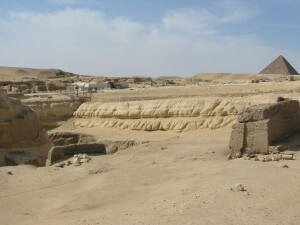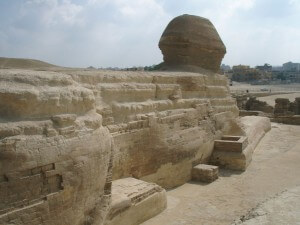
Egypt: Geological evidence suggests that the Sphinx is an ancient 800000 flight
 06. 06. 2018
06. 06. 2018

One of the most mysterious and the most mysterious objects on Earth's surface is undoubtedly Sphinx in Egypt on the Giza Plateau. It is an ancient building that employs researchers from its rediscovery to the present. So far, no one is able to determine her age with absolute certainty. There are no clear written records of the time of the Sphinx. Now, two Ukrainian researchers have put forward a provocative theory in which they assume that the Great Sphinx in Egypt is at least 800 years old. This revolutionary idea is supported by scientific knowledge.
Sphinx and scientific study
The scientific study was presented at the International Conference on Geoarchaeology and Archaeomineralogy in Sofia under the title Geological aspect of the dating of the Great Egyptian Sphinx.
The authors of the article are two scientists: Manichev Vjacheslav I. (Institute of Environmental Geochemistry of the National Academy of Sciences of Ukraine) and Alexander G. Parkhomenko (Institute of Geography of the National Academy of Sciences of Ukraine).
The starting point of the work of these two experts was the work presented by John A. West and PhD. Robert M. Schoch (Professor of Natural Sciences at the College of General Studies). They were the first to initiate a debate with orthodox Egyptologists on the topic that the Sphinx could come from a much earlier time. The key evidence is the remains of water erosion on the surface and around the monument itself on the Giza Plateau.
Manichev and Parkhomenko report
"The problem of Sphinx dating is still relevant, despite the long history of research. The geological view in conjunction with other scientific methods makes it possible to answer the question of the relative age of the Sphinx. From the visual investigation, it can be concluded that water has played a significant role in what the Sphinx looks today. We can see that the monument was partially flooded. We can also see it on the vertical perimeter walls. "
This strong argument from Ukrainian scientists supported geological studies at the same time with the study of RA Schoch and his view of the dating of the Sphinx. Manichev and Parkhomenko focused on the damage to the body of the Sphinx. They leave aside the erosive damage to the place where the Sphinx is located, which were previously investigated by RA Schoch.
Sphing and its erosive damage
Traditional scientists offer an explanation that the Sphinx was sandy and sandy. The ripple is then caused by the harder layers of the rocks being more resistant to erosion, and softer layers were more affected.
Manichev and Parkhomenko object: But why don't we see such damage on the front of the Sphinx - on her head? As for the arguments made by RA Schoch about heavy rain around 13000 BC, Ukrainian scientists accept Schoch's hypothesis. But they go much further and lean towards the idea that the erosive properties found are much older than 13000 years BC.
Manichev and Parkhomenko are of the opinion that they know the mountain coasts of the Caucasus and Crimea well. Here are typical cases of wind erosion, which, however, differ morphologically from those we can see on the Sphinx. In fact argues that the geological differences of wind erosion should be similar regardless of the geological composition of the rocks.
Manichev and Parkhomenko maintain
"During our geological expeditions through various mountains and littoral zones in the Crimea and the Caucasus, we were often able to observe forms of eolian weathering, which, however, differ significantly in nature from what we can observe on the Giza Plateau near the Sphinx (GES). This is because most natural forms of weathering are formed in a similar way, independent of the lithological composition of the rocks.
Our personal experience with the scientific study of coastal geology is the reason for the analogy with GES and our efforts to suggest another way in which it has been damaged. Specialized geologists who have worked in the fields of coastal geomorphology are aware of similar forms of relief wavy cavity cutting (Morskaya Geomorfologiya, 1980). Such cases may be single or multi-storey. The individual floors are then arranged horizontally with the water level. Particularly deep wrinkles (similar to GES) are visible in steep cliffs, which consist of carbonaceous rocks.
These forms of relief are well known and have been studied in detail at the Black Sea on the coasts of the Caucasus and Crimea (Popov, 1953, Zenkovich, 1960). A general model for the formation of such a fragmented fold in the rocks on the Caucasian flysch is described by Popov (1953, page 162; Fig. 3). In the dynamic process of wavy wrinkling, it can be seen that the energy of the waves is directed to the rock layer at the water level. Among other things, salt and fresh water is able to dissolve rocks. "
Sphinx and wrinkles
Manichev and Parkhomenko propose a new natural mechanism that can explain the causes of the Sphinx wrinkles. This mechanism is based on the principle of incident waves on the rocky shore. Something like this could happen over a period of thousands of years. We can just see something like this by the Black Sea. This process, which acts horizontally (ie when the waves hit a rocky surface), causes the rock to wear and dissolve.
The fact is that if we compare the GES with what we can see elsewhere, Ukrainian scientists believe that this monument could be affected as described due to long-term immersion in a large body of water and not just regular floods from the Nile.
Manichev and Parkhomenko suggest that The geological composition of the body of the Sphinx is a sequence of layers composed of limestone with small clay components. Manichev and Parkhomenko explain that these rocks have varying degrees of water resistance. If someone claims that the depressions on the GES were caused only by sand abrasion, the layers in the cavities would have to correspond to certain lithological compositions. They suggest that the cavities on the Great Sphinx are in fact formed in several layers, or that some parts of the layers have a homogeneous composition.
Manichev and Parkhomenko firmly believes that the Sphinx was immersed in water for many years. They support this hypothesis by pointing to existing literature on geological studies at the Giza Plateau. According to these studies at the end of the Pliocene geological period (approximately between 5,2 and 1,6 millions of years ago), sea water entered the Nile Valley and gradually created flooding. This led to the formation of lake deposits, which are still visible at the level of 180 meters above the current level of the Mediterranean Sea.
Estimated Age of Sphinx
According to Manicheva and Parkhomenkova, the sea level during the Calabrian phase is the closest to the highest level of GES wrinkling. High levels of seawater have also caused Nile overflow and long-lasting water areas. In terms of timing, the closest corresponds to the period around 800000 years to the past.
What we have here is evidence that contradicts the conventional theory of sand and water damage. This theory has been criticized by JA West and RA Schoch, who recalled that over the centuries, the body of the Sphinx had been buried in desert sand, so wind and sand erosion had no chance of doing any damage to the mysterious Sphinx.
However, where RA Schoch clearly saw the flow of water caused by continuous rain, Ukrainian geologists see the effect of erosion caused by the direct contact of the Pleistocene water lakes formed on the body of the Sphinx. This would mean that the Great Sphinx in Egypt is one of the oldest landmarks on Earth. This would drastically remove the origin of humanity and civilization into the past. In fact, we would get closer to what the historical records of our ancestors say - Mayan or Indian legends.
One might say that the theory proposed by Manichev and Parkhomenkov is very extreme, because it builds the Great Sphinx to a time when, according to our ideas, there were no people there. In addition, two megalithic temples, which are located in close proximity to the Great Sphinx, were proven to be built of the same stone. This means that the new dating of the Sphinx drags these monuments back to the Sphinx back to 800 years ago. In other words, in ancient times our civilization inhabited our planet, about which we do not know much yet. But all this is a thorn in the side of the mainstream of science.
Want to learn more about ancient technologies? We will talk about them today, 6.6.2018 from 20.hour on ours YouTube channel Suenee Universe. We will talk about:
- Egypt and acoustic resonance
- About how the pyramids work and what they most likely served
- The giant and extinct developed civilizations at home and around the world
- Spiritual Mystic
- Blind boulders
- Scientific approach to finding reality





 1
1

